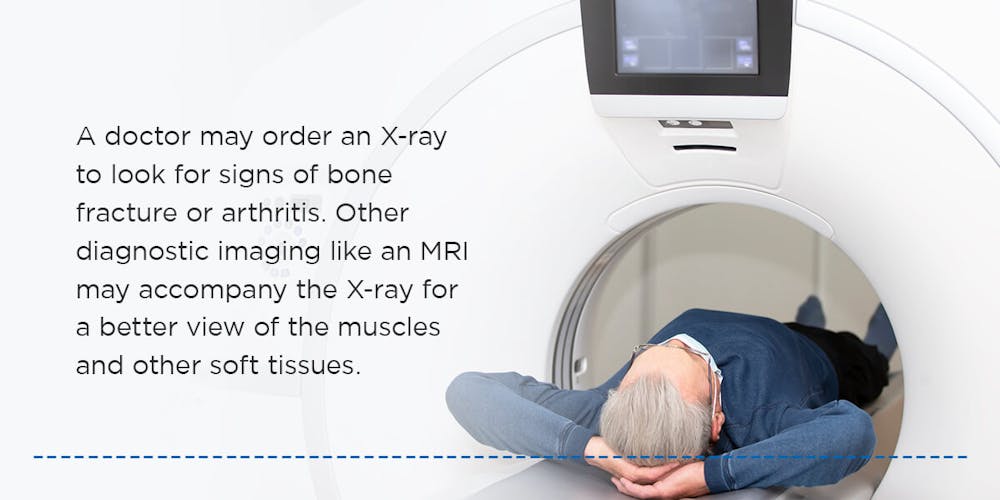Whether it’s your first time encountering a back spasm or you’ve had multiple occurrences, you know they can be incredibly inconvenient, painful and frightening. But fret not — we have plenty of tips for keeping your back spasms at bay. Learn about symptoms, causes and what to do for back spasms in this guide.
What Is a Back Spasm?
A back spasm is a sudden, involuntary contraction, twinge or seizure of one or multiple spinal muscles. Back spasms can occur in any part of the back — lower, middle or upper. However, lower back spasms tend to be the most common.
A back spasm can range anywhere from a dull twitch or ache to a sharp, crippling and debilitating pain. It can emerge without warning or start as a mild twitch that grows increasingly painful.
Back spasms often occur from injuries and muscle overuse. A back spasm might also indicate a more serious condition, like a micro-tear around a spinal disc.
Things like awkward sleeping positions, bending, lifting or even sitting and standing can sometimes cause spasms, but the exact cause isn’t always clear. However, many back spasms stem from mild muscle injuries like sprains.
Signs and Symptoms of Back Spasms
Depending on the severity of the back spasm, it may cause one or more of the following symptoms:
- A tight knot
- Difficulty moving or bending
- Sudden and sporadic cramping
- Muscle weakness in legs or arms
- Loss of bowel or bladder control
- Weakness, numbness or other odd sensations on one side of the body
- Lost feeling in one or multiple limbs
- Reduced balance and coordination
What Causes Back Spasms?
Some common causes of muscle spasms in the back include:
- Poor posture: Improper standing or sitting posture can strain the back muscles.
- Mild injury: A muscle sprain or strain resulting from an abnormal twist, bend or fall may trigger a back spasm.
- Muscle overuse: Heavy, repetitive and prolonged lifting movements from manual labor or sports can injure and inflame the back muscles, especially without sufficient rest and recovery.
- Nutrient deficiencies: A lack of essential minerals and vitamins like magnesium, potassium and vitamin D may interfere with muscle function, causing back pain and spasms.
- Stress and anxiety: Stress and anxiety can tighten the back and neck muscles. This prolonged muscle tension can cause spasms and stiffness.
- Lack of physical activity: Insufficient regular physical activity can weaken the back and abdominal muscles, potentially causing recurrent back pain or spasms.
- Herniated disc: A ruptured or herniated disc occurs when the disc compresses, cracks and bulges out of the spine. This can hinder your ability to move or exercise, potentially causing muscle weakness that leads to back spasms.
- Arthritis: Inflammatory arthritis that impacts the spine — like osteoarthritis and ankylosing spondylitis — can trigger painful back spasms. Like with other painful, chronic conditions, people with arthritis may become less physically active, potentially causing muscle weakness and spasms.
- Spinal conditions: Spondylolisthesis causes part of the spine to slip out of position, while spinal stenosis is the narrowing of the spinal canal that puts pressure on the nerves or spinal cord. Both of these conditions can cause back pain, inflammation, stiffness and muscle spasms.
- Fibromyalgia: Fibromyalgia is a chronic condition involving pain and sensitivity in multiple bodily areas. People with fibromyalgia often experience muscle spasms.
Who Is Most Susceptible to Back Spasms?
While anyone can experience back spasms, the following groups are especially prone to them:
- Athletes and workers who regularly lift heavy objects
- People with chronic back and spinal conditions
- People with sedentary lifestyles and muscle weakness
- People with poor posture and low nutrient intake
Some other risk factors for lower back spasms include:
- Age
- Excess weight
- Smoking
- Emotional stress and other psychological conditions
How Are Back Spasms Diagnosed?
A doctor may order an X-ray to look for signs of bone fracture or arthritis. Other diagnostic imaging like an MRI may accompany the X-ray for a better view of the muscles and other soft tissues. These exams may also help identify potential issues with discs or blood flow around the affected site.
Explaining your symptoms in detail can also help your doctor provide an accurate diagnosis. Discuss details like the severity of your back pain, when you started experiencing spasms, how often they occur and things that ease the pain.
Whether you started having spasms after a sports injury, taking a medication or moving a heavy piece of furniture, knowing these details in full can help your doctor determine the cause and proper treatment method for your spasms.
How Are Back Spasms Managed and Treated?
Below are some common treatment and management methods if you’re wondering how to get back spasm relief:
- Rest: Sit or lie down in a comfortable position on a bed or couch. When lying down, bend your knees slightly and place a pillow beneath them to take pressure off your back. Try to avoid twisted positions or sitting upright in bed, as these can strain your back muscles.
- Massaging: Massaging the affected area can help reduce muscle tension and stop a spasm. Apply gentle pressure and move your hand in circular motions for about a minute at a time.
- Hot and cold compresses: When a spasm occurs, ice the affected area for about 20 minutes to reduce pain and inflammation. You can also apply a heat pack to relax the muscle and stimulate blood flow. Alternate between cold and hot compresses as necessary.
- Over-the-counter medications: Over-the-counter medications like naproxen and ibuprofen can help reduce pain and inflammation.
- Relaxation techniques: Deep breathing exercises can help ease muscle tension and reduce stress.
- Low-impact activity: It’s important to rest for a day or two, but prolonged inactivity may stiffen the muscles and delay healing. Take brief walks while avoiding uneven surfaces and hills. You can also try some gentle lower back stretches or a foam roller to relax the muscles.
Your doctor may prescribe medication if your back spasms aren’t improving with home care. They may also recommend exercise or physical therapy to improve strength and flexibility in your back muscles. Consistent care is key to back spasm treatment. Be sure to attend all doctor’s appointments and contact your health care provider if you experience any problems.
Visit the New York Spine Institute for Back Spasm Treatment and Relief
If you’re seeking care for back spasms, our team at the New York Spine Institute can assist you. As one of the tri-state’s largest orthopedic and multi-specialty spine centers, we can determine and address the root cause of your muscle spasms and find the best treatment approach.
We offer an array of specialized services including diagnostics, pain management, physical therapy and more. Our highly trained specialists can help relieve your symptoms, provide treatment for back pain/spasms, and prevent future spasms.
Don’t let painful and troublesome back spasms disrupt your normal activities and life. Contact us today to set up an appointment to get back muscle spam relief.


